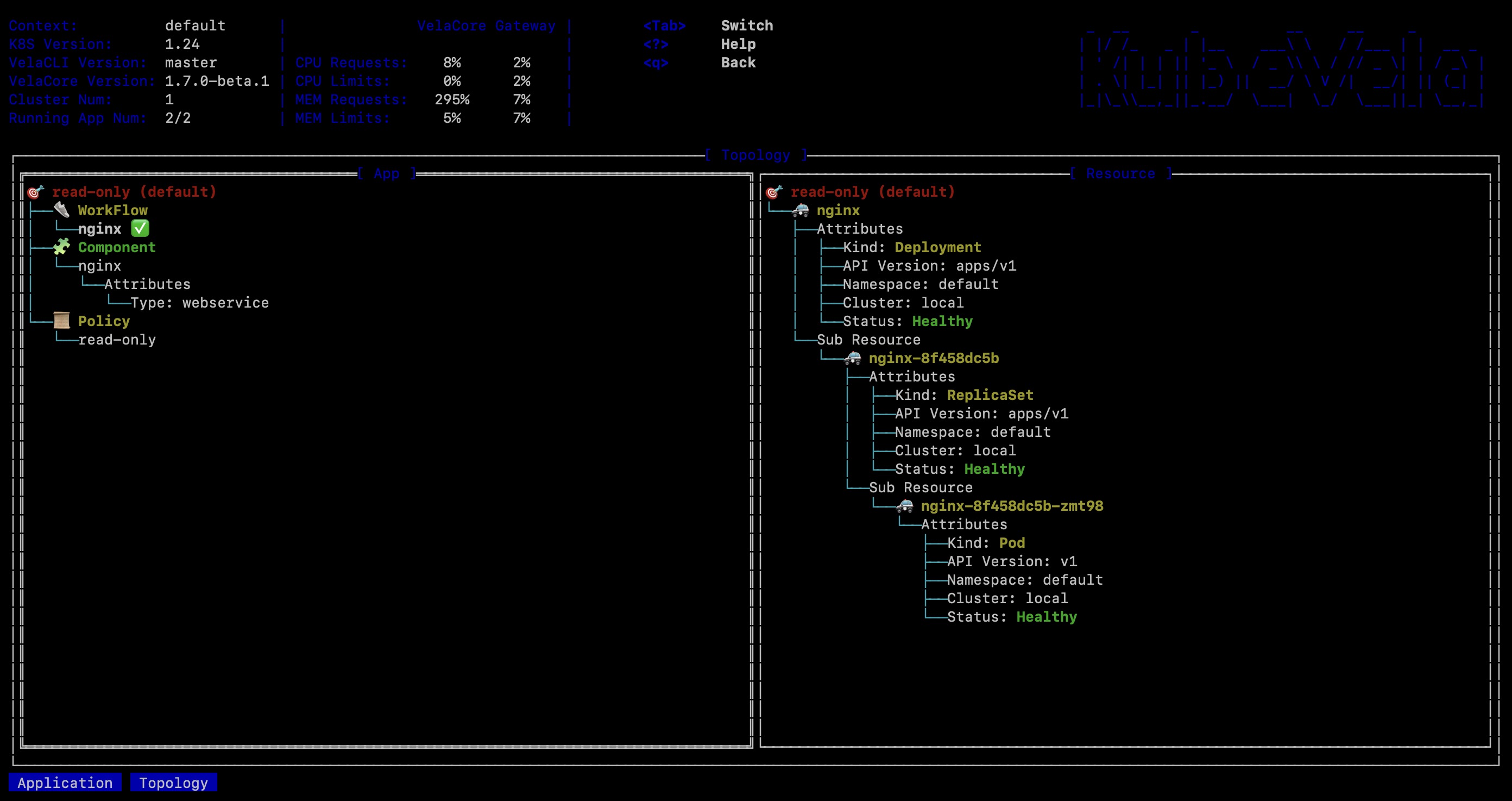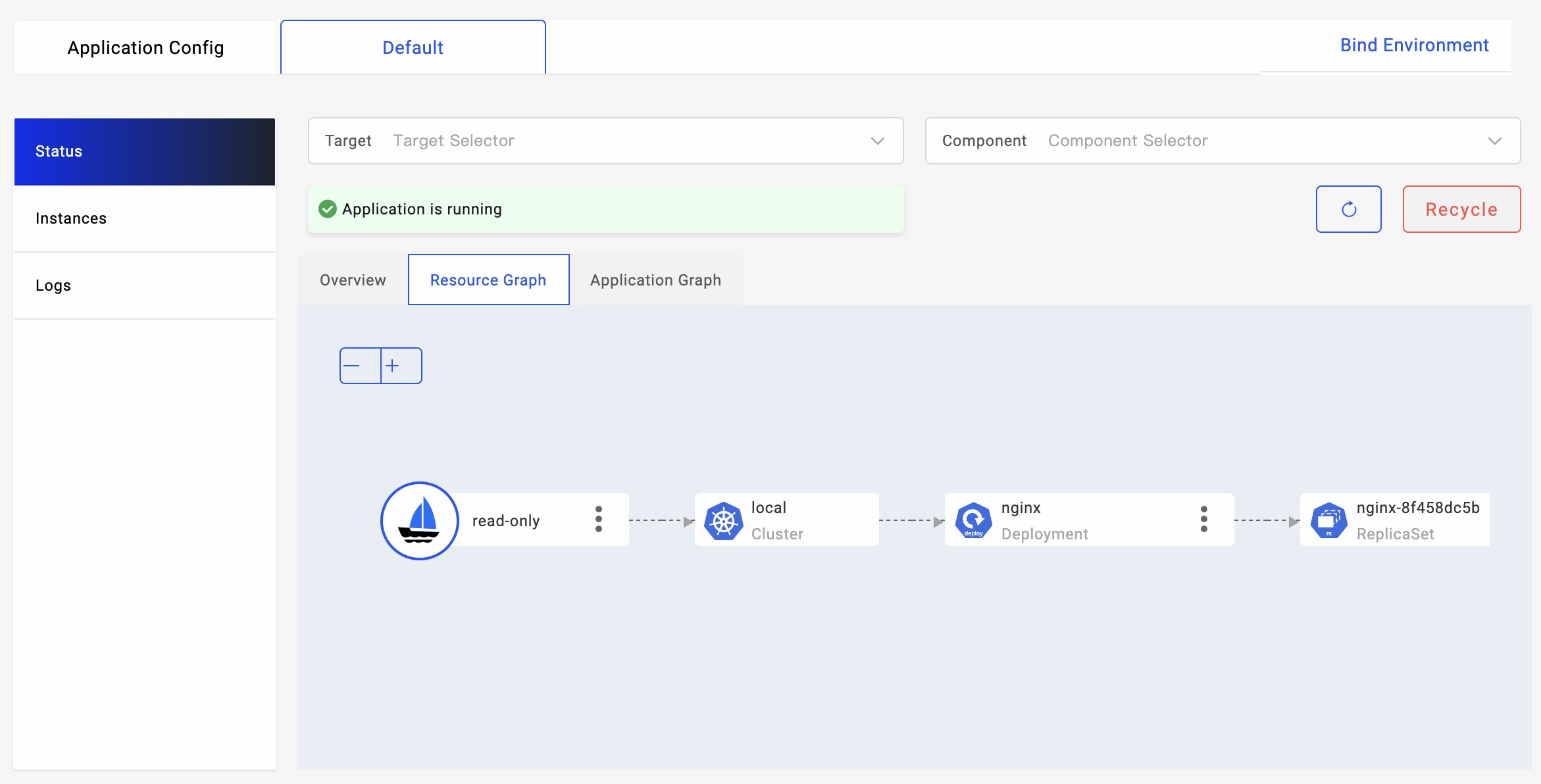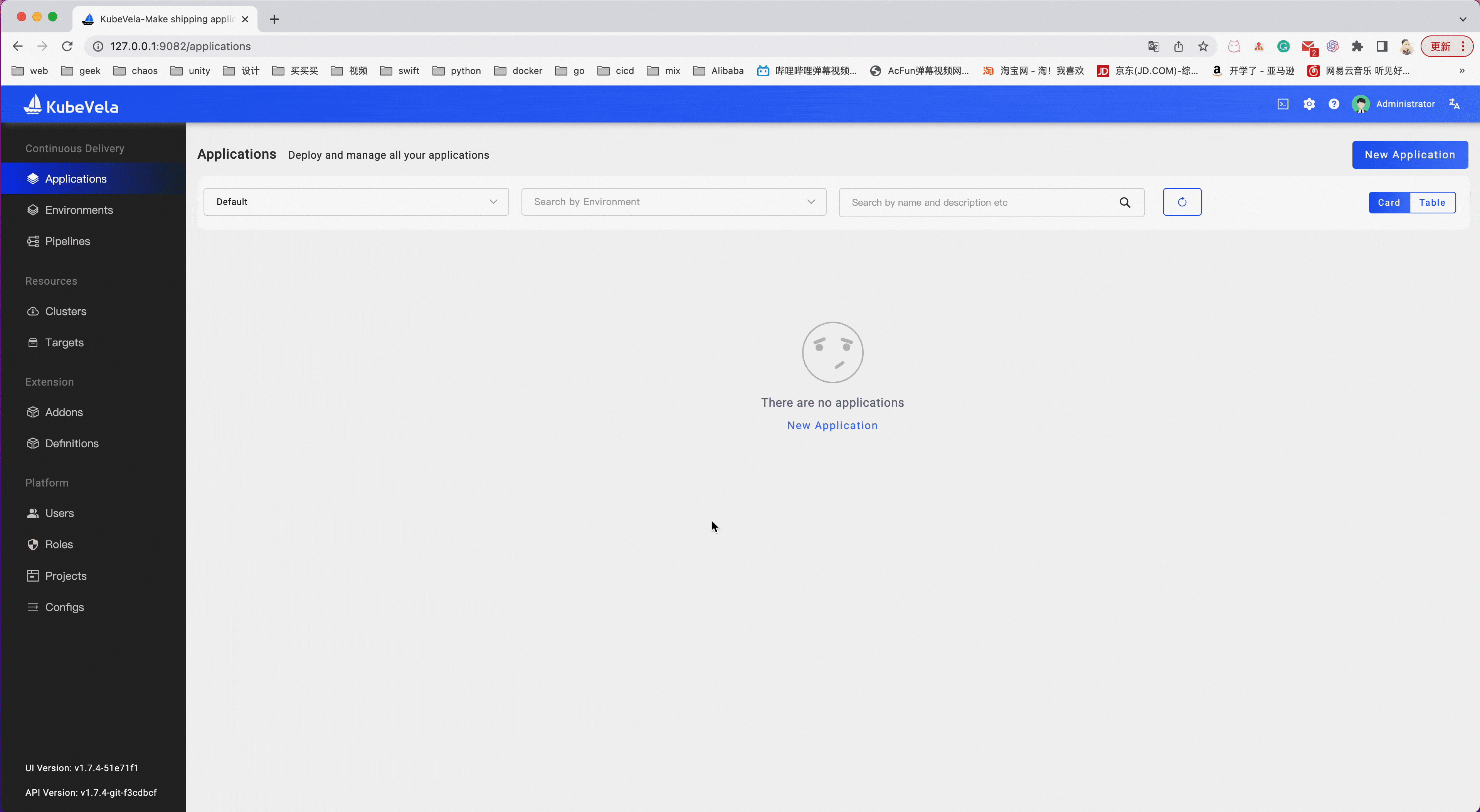Resource Adoption
There are times that you might want to use KubeVela application to adopt existing resources or from other sources like Helm release. In this case, you can leverage the capability of resource adoption in KubeVela.
Use in Application
By default, when KubeVela application tries to dispatch (create or update) one resource, it will first check if this resource belongs to itself. This check is done by comparing the label values of app.oam.dev/name & app.oam.dev/namespace and see whether they are equal to the application's name & namespace.
If this resource does not belongs to the application itself (belongs to no one or some other application), the application will stop the dispatch operation and report an error. This mechanism is designed to prevent unintended edits to resources managed by other operators or systems.
If the resource is currently managed by other applications, you can refer to shared-resource policy and read more about sharing resources across multiple applications.
If the resource is managed by no one, to allow KubeVela application to manage the resource, you can leverage the read-only policy or take-over policy to enforce resource adoption on these resources.
ReadOnly Policy
With read-only policy, you can select resources that could be adopted by the current application. For example, in the below application, Deployment typed resources are treated as read-only resources and are able to be adopted by the given application.
apiVersion: core.oam.dev/v1beta1
kind: Application
metadata:
name: read-only
spec:
components:
- name: nginx
type: webservice
properties:
image: nginx
policies:
- type: read-only
name: read-only
properties:
rules:
- selector:
resourceTypes: ["Deployment"]
The read-only policy allows application to read the selected resources but will skip all edits to the target resource. Error will be reported if the target resource does not exist.
The target resource will NOT be attached with the application's label. It is possible for multiple applications to use the same resource with read-only policy concurrently. The deletion of the application will also skip the recycle process of the target resources.
Although the resources selected in the read-only policy will not be editable through application, both health check and resource topology graph can work normally. Therefore, you can use KubeVela application with read-only policy to build "monitoring group" for underlying resources and leverage tools such as vela top or velaux to observe them, without any modification.
practice
- First create the nginx deployment.
kubectl create deploy nginx --image=nginx
- Deploy the application with
read-onlypolicy.
cat <<EOF | vela up -f -
apiVersion: core.oam.dev/v1beta1
kind: Application
metadata:
name: read-only
spec:
components:
- name: nginx
type: webservice
properties:
image: nginx
policies:
- type: read-only
name: read-only
properties:
rules:
- selector:
resourceTypes: ["Deployment"]
EOF
- Check the running status of the application.
vela status read-only
Use
vela topto see the resource topology of the application.
Use
velauxto see the resource topology graph of the application.
TakeOver Policy
In the case you not only want KubeVela application to observe underlying resource but also want the application to be able to edit them, you can use the take-over policy in replace of the read-only policy.
apiVersion: core.oam.dev/v1beta1
kind: Application
metadata:
name: take-over
spec:
components:
- name: nginx-take-over
type: k8s-objects
properties:
objects:
- apiVersion: apps/v1
kind: Deployment
metadata:
name: nginx
traits:
- type: scaler
properties:
replicas: 3
policies:
- type: take-over
name: take-over
properties:
rules:
- selector:
resourceTypes: ["Deployment"]
In the above application, the nginx deployment will be added with owner labels and marked as belonged to the current app. The attached scaler trait in the application will modify the replica number of the target deployment to 3, while keeping all other fields untouched.
After the resource is taken over by the application, the application will control the upgrades and deletion of the target resource. Therefore, differ from read-only policy, each resource can only be managed by one application with take-over policy.
The take-over policy is helpful when you want to let the application to take the complete control for the given resources.
practice
- First create the nginx deployment
kubectl create deploy nginx --image=nginx
- Deploy the application with
take-overpolicy.
cat <<EOF | vela up -f -
apiVersion: core.oam.dev/v1beta1
kind: Application
metadata:
name: take-over
spec:
components:
- name: nginx-take-over
type: k8s-objects
properties:
objects:
- apiVersion: apps/v1
kind: Deployment
metadata:
name: nginx
traits:
- type: scaler
properties:
replicas: 3
policies:
- type: take-over
name: take-over
properties:
rules:
- selector:
resourceTypes: ["Deployment"]
EOF
- Check the application running status.
vela status take-over
Use in CLI
The read-only policy and take-over policy provide a way for users to directly adopt resources within KubeVela application api. If you prefer directly build KubeVela application by existing resources from scratch, you can use the vela adopt CLI command.
Adopt Native Resource
By providing a list of native Kubernetes resources, vela adopt command can help you automatically adopt those resources in an application. You can follow the below procedure to try it out.
- Create some resources for adoption.
kubectl create deploy example --image=nginx
kubectl create service clusterip example --tcp=80:80
kubectl create configmap example
kubectl create secret generic example
- Run
vela adoptcommand to create an application that contains all the resource mentioned above.
vela adopt deployment/example service/example configmap/example secret/example
expected output
apiVersion: core.oam.dev/v1beta1
kind: Application
metadata:
creationTimestamp: null
labels:
app.oam.dev/adopt: native
name: example
namespace: default
spec:
components:
- name: example.Deployment.example
properties:
objects:
- apiVersion: apps/v1
kind: Deployment
metadata:
name: example
namespace: default
spec:
progressDeadlineSeconds: 600
replicas: 1
revisionHistoryLimit: 10
selector:
matchLabels:
app: example
strategy:
rollingUpdate:
maxSurge: 25%
maxUnavailable: 25%
type: RollingUpdate
template:
metadata:
creationTimestamp: null
labels:
app: example
spec:
containers:
- image: nginx
imagePullPolicy: Always
name: nginx
resources: {}
terminationMessagePath: /dev/termination-log
terminationMessagePolicy: File
dnsPolicy: ClusterFirst
restartPolicy: Always
schedulerName: default-scheduler
securityContext: {}
terminationGracePeriodSeconds: 30
type: k8s-objects
- name: example.Service.example
properties:
objects:
- apiVersion: v1
kind: Service
metadata:
name: example
namespace: default
spec:
clusterIP: 10.43.65.46
clusterIPs:
- 10.43.65.46
internalTrafficPolicy: Cluster
ipFamilies:
- IPv4
ipFamilyPolicy: SingleStack
ports:
- name: 80-80
port: 80
protocol: TCP
targetPort: 80
selector:
app: example
sessionAffinity: None
type: ClusterIP
type: k8s-objects
- name: example.config
properties:
objects:
- apiVersion: v1
kind: ConfigMap
metadata:
name: example
namespace: default
- apiVersion: v1
kind: Secret
metadata:
name: example
namespace: default
type: k8s-objects
policies:
- name: read-only
properties:
rules:
- selector:
componentNames:
- example.Deployment.example
- example.Service.example
- example.config
type: read-only
status: {}
By default, the application first embeds all the given resources in its components. Then it attaches the read-only policy. You can edit the returned configuration and make your own adoption application. Or you can directly apply this application with the --apply arg.
vela adopt deployment/example service/example configmap/example secret/example --apply
You can also set the application name you would like to use.
vela adopt deployment/example service/example configmap/example secret/example --apply --app-name=adopt-example
Now if you can use vela status and vela status -t -d command show the status the applied application.
vela status adopt-example
expected output
About:
Name: adopt-example
Namespace: default
Created at: 2023-01-11 14:21:21 +0800 CST
Status: running
Workflow:
mode: DAG-DAG
finished: true
Suspend: false
Terminated: false
Steps
- id: 8d8capzw7e
name: adopt-example.Deployment.example
type: apply-component
phase: succeeded
- id: 6u6c6ai1gu
name: adopt-example.Service.example
type: apply-component
phase: succeeded
- id: r847uymujz
name: adopt-example.config
type: apply-component
phase: succeeded
Services:
- Name: adopt-example.Deployment.example
Cluster: local Namespace: default
Type: k8s-objects
Healthy
No trait applied
- Name: adopt-example.Service.example
Cluster: local Namespace: default
Type: k8s-objects
Healthy
No trait applied
- Name: adopt-example.config
Cluster: local Namespace: default
Type: k8s-objects
Healthy
No trait applied
vela status adopt-example -t -d
CLUSTER NAMESPACE RESOURCE STATUS APPLY_TIME DETAIL
local ─── default ─┬─ ConfigMap/example updated 2023-01-11 14:15:34 Data: 0 Age: 6m1s
├─ Secret/example updated 2023-01-11 14:15:52 Type: Opaque Data: 0 Age: 5m43s
├─ Service/example updated 2023-01-11 14:12:00 Type: ClusterIP Cluster-IP: 10.43.65.46 External-IP: <none> Port(s): 80/TCP Age: 9m35s
└─ Deployment/example updated 2023-01-11 14:11:06 Ready: 1/1 Up-to-date: 1 Available: 1 Age: 10m
The read-only only allows the application to observe resources, but disallow any edits to it. If you want to make modifications you can use the --mode=take-over to use the take-over policy in the adoption application.
Adopt Helm Release
vela adopt also supports directly reading native resources from existing helm release. This is helpful if you previously deployed resources through helm.
- For example, you can firstly deploy a mysql instance through helm.
helm repo add bitnami https://charts.bitnami.com/bitnami
helm repo update
helm install mysql bitnami/mysql
- You can validate the installation through
helm ls.
helm ls
NAME NAMESPACE REVISION UPDATED STATUS CHART APP VERSION
mysql default 1 2023-01-11 14:34:36.653778 +0800 CST deployed mysql-9.4.6 8.0.31
- Run
vela adoptcommand to adopt resources from existing release. Similar to native resource adoption, you can get a KubeVela application withread-onlypolicy.
vela adopt mysql --type helm
expected output
apiVersion: core.oam.dev/v1beta1
kind: Application
metadata:
creationTimestamp: null
labels:
app.oam.dev/adopt: helm
name: mysql
namespace: default
spec:
components:
- name: mysql.StatefulSet.mysql
properties:
objects:
- apiVersion: apps/v1
kind: StatefulSet
metadata:
name: mysql
namespace: default
spec:
podManagementPolicy: ""
replicas: 1
selector:
matchLabels:
app.kubernetes.io/component: primary
app.kubernetes.io/instance: mysql
app.kubernetes.io/name: mysql
serviceName: mysql
template:
metadata:
annotations:
checksum/configuration: f8f3ad4a6e3ad93ae6ed28fdb7f7b4ff9585e08fa730e4e5845db5ebe5601e4d
labels:
app.kubernetes.io/component: primary
app.kubernetes.io/instance: mysql
app.kubernetes.io/managed-by: Helm
app.kubernetes.io/name: mysql
helm.sh/chart: mysql-9.4.6
spec:
affinity:
nodeAffinity: null
podAffinity: null
podAntiAffinity:
preferredDuringSchedulingIgnoredDuringExecution:
- podAffinityTerm:
labelSelector:
matchLabels:
app.kubernetes.io/instance: mysql
app.kubernetes.io/name: mysql
topologyKey: kubernetes.io/hostname
weight: 1
containers:
- env:
- name: BITNAMI_DEBUG
value: "false"
- name: MYSQL_ROOT_PASSWORD
valueFrom:
secretKeyRef:
key: mysql-root-password
name: mysql
- name: MYSQL_DATABASE
value: my_database
envFrom: null
image: docker.io/bitnami/mysql:8.0.31-debian-11-r30
imagePullPolicy: IfNotPresent
livenessProbe:
exec:
command:
- /bin/bash
- -ec
- |
password_aux="${MYSQL_ROOT_PASSWORD:-}"
if [[ -f "${MYSQL_ROOT_PASSWORD_FILE:-}" ]]; then
password_aux=$(cat "$MYSQL_ROOT_PASSWORD_FILE")
fi
mysqladmin status -uroot -p"${password_aux}"
failureThreshold: 3
initialDelaySeconds: 5
periodSeconds: 10
successThreshold: 1
timeoutSeconds: 1
name: mysql
ports:
- containerPort: 3306
name: mysql
readinessProbe:
exec:
command:
- /bin/bash
- -ec
- |
password_aux="${MYSQL_ROOT_PASSWORD:-}"
if [[ -f "${MYSQL_ROOT_PASSWORD_FILE:-}" ]]; then
password_aux=$(cat "$MYSQL_ROOT_PASSWORD_FILE")
fi
mysqladmin status -uroot -p"${password_aux}"
failureThreshold: 3
initialDelaySeconds: 5
periodSeconds: 10
successThreshold: 1
timeoutSeconds: 1
resources:
limits: {}
requests: {}
securityContext:
runAsNonRoot: true
runAsUser: 1001
startupProbe:
exec:
command:
- /bin/bash
- -ec
- |
password_aux="${MYSQL_ROOT_PASSWORD:-}"
if [[ -f "${MYSQL_ROOT_PASSWORD_FILE:-}" ]]; then
password_aux=$(cat "$MYSQL_ROOT_PASSWORD_FILE")
fi
mysqladmin status -uroot -p"${password_aux}"
failureThreshold: 10
initialDelaySeconds: 15
periodSeconds: 10
successThreshold: 1
timeoutSeconds: 1
volumeMounts:
- mountPath: /bitnami/mysql
name: data
- mountPath: /opt/bitnami/mysql/conf/my.cnf
name: config
subPath: my.cnf
initContainers: null
securityContext:
fsGroup: 1001
serviceAccountName: mysql
volumes:
- configMap:
name: mysql
name: config
updateStrategy:
type: RollingUpdate
volumeClaimTemplates:
- metadata:
annotations: null
labels:
app.kubernetes.io/component: primary
app.kubernetes.io/instance: mysql
app.kubernetes.io/name: mysql
name: data
spec:
accessModes:
- ReadWriteOnce
resources:
requests:
storage: 8Gi
type: k8s-objects
- name: mysql.Service.mysql
properties:
objects:
- apiVersion: v1
kind: Service
metadata:
name: mysql
namespace: default
spec:
ports:
- name: mysql
nodePort: null
port: 3306
protocol: TCP
targetPort: mysql
selector:
app.kubernetes.io/component: primary
app.kubernetes.io/instance: mysql
app.kubernetes.io/name: mysql
sessionAffinity: None
type: ClusterIP
type: k8s-objects
- name: mysql.Service.mysql-headless
properties:
objects:
- apiVersion: v1
kind: Service
metadata:
name: mysql-headless
namespace: default
spec:
clusterIP: None
ports:
- name: mysql
port: 3306
targetPort: mysql
publishNotReadyAddresses: true
selector:
app.kubernetes.io/component: primary
app.kubernetes.io/instance: mysql
app.kubernetes.io/name: mysql
type: ClusterIP
type: k8s-objects
- name: mysql.config
properties:
objects:
- apiVersion: v1
kind: Secret
metadata:
name: mysql
namespace: default
- apiVersion: v1
kind: ConfigMap
metadata:
name: mysql
namespace: default
type: k8s-objects
- name: mysql.sa
properties:
objects:
- apiVersion: v1
kind: Secret
metadata:
name: mysql
namespace: default
- apiVersion: v1
kind: ConfigMap
metadata:
name: mysql
namespace: default
type: k8s-objects
policies:
- name: read-only
properties:
rules:
- selector:
componentNames:
- mysql.StatefulSet.mysql
- mysql.Service.mysql
- mysql.Service.mysql-headless
- mysql.config
- mysql.sa
type: read-only
status: {}
- You can similarly use
--applyparameter to apply the application into cluster and use--mode=take-overto allow modifications by enforcingtake-overpolicy. In addition to that, if you want to completely adopt resources in helm chart into KubeVela application and disable the management of that helm chart (prevent multiple sources), you can add--recycleflag to remove the helm release secret after the application has entered running status.
vela adopt mysql --type helm --mode take-over --apply --recycle
resources adopted in app default/mysql
successfully clean up old helm release
- You can check the application status using
vela statusandvela status -t -d.
vela status mysql
expected output
About:
Name: mysql
Namespace: default
Created at: 2023-01-11 14:40:16 +0800 CST
Status: running
Workflow:
mode: DAG-DAG
finished: true
Suspend: false
Terminated: false
Steps
- id: orq8dnqbyv
name: mysql.StatefulSet.mysql
type: apply-component
phase: succeeded
- id: k5kwoc49jv
name: mysql.Service.mysql-headless
type: apply-component
phase: succeeded
- id: p5qe1drkoh
name: mysql.Service.mysql
type: apply-component
phase: succeeded
- id: odicbhtf9a
name: mysql.config
type: apply-component
phase: succeeded
- id: o36adyqqal
name: mysql.sa
type: apply-component
phase: succeeded
Services:
- Name: mysql.StatefulSet.mysql
Cluster: local Namespace: default
Type: k8s-objects
Healthy
No trait applied
- Name: mysql.Service.mysql-headless
Cluster: local Namespace: default
Type: k8s-objects
Healthy
No trait applied
- Name: mysql.Service.mysql
Cluster: local Namespace: default
Type: k8s-objects
Healthy
No trait applied
- Name: mysql.config
Cluster: local Namespace: default
Type: k8s-objects
Healthy
No trait applied
- Name: mysql.sa
Cluster: local Namespace: default
Type: k8s-objects
Healthy
No trait applied
vela status mysql -t -d
CLUSTER NAMESPACE RESOURCE STATUS APPLY_TIME DETAIL
local ─── default ─┬─ ConfigMap/mysql updated 2023-01-11 14:40:16 Data: 1 Age: 7m41s
├─ Secret/mysql updated 2023-01-11 14:40:16 Type: Opaque Data: 2 Age: 7m41s
├─ Service/mysql updated 2023-01-11 14:40:16 Type: ClusterIP Cluster-IP: 10.43.154.7 External-IP: <none> Port(s): 3306/TCP Age: 7m41s
├─ Service/mysql-headless updated 2023-01-11 14:40:16 Type: ClusterIP Cluster-IP: None External-IP: <none> Port(s): 3306/TCP Age: 7m41s
└─ StatefulSet/mysql updated 2023-01-11 14:40:16 Ready: 1/1 Age: 7m41s
- If you run
helm lsyou will not be able to find the original mysql helm release since the records have been recycled.
helm ls
NAME NAMESPACE REVISION UPDATED STATUS CHART APP VERSION
There are multiple ways to use KubeVela together with Helm.
If you want to use Helm to control the release process of charts and use KubeVela to monitor those resources, you can use the default mode (read-only) and do not recycle the helm release secret. In this case, you will be able to monitor resources dispatched by Helm Chart with KubeVela tools or eco-system (like viewing on Grafana).
If you want to migrate existing resources from Helm Chart to KubeVela application, you can use the take-over mode and use the --apply flag to recycle helm release records.
Customized Adoption
By default, vela adopt will take resources from given source (native resource list or helm chart) and group them into different components. For resources like Deployments or Statefulsets, the original spec will be reserved. For other resources like ConfigMap or Secret, the data will not be recorded in the adoption application (which means the application does not care for the content in them). For special resources (CustomResourceDefinition), the garbage-collect and apply-once policy will be additionally attached in the application.
The conversion from resources into application is achieved by using the CUE template. You can refer to GitHub to see the default template.
You can also build your own adoption rule using CUE and add --adopt-template to vela adopt command.
- For example, let's create an example deployment.
kubectl create deploy custom-adopt --image=nginx
- Create a file named
my-adopt-rule.cue.
import "list"
#Resource: {
apiVersion: string
kind: string
metadata: {
name: string
namespace?: string
...
}
...
}
#Component: {
type: string
name: string
properties: {...}
dependsOn?: [...string]
traits?: [...#Trait]
}
#Trait: {
type: string
properties: {...}
}
#Policy: {
type: string
name: string
properties?: {...}
}
#Application: {
apiVersion: "core.oam.dev/v1beta1"
kind: "Application"
metadata: {
name: string
namespace?: string
labels?: [string]: string
annotations?: [string]: string
}
spec: {
components: [...#Component]
policies?: [...#Policy]
workflow?: {...}
}
}
#AdoptOptions: {
mode: *"read-only" | "take-over"
type: *"helm" | string
appName: string
appNamespace: string
resources: [...#Resource]
...
}
#Adopt: {
$args: #AdoptOptions
$returns: #Application
// adopt logics
$returns: #Application & {
metadata: {
name: $args.appName
labels: "app.oam.dev/adopt": $args.type
}
spec: components: [for r in $args.resources if r.kind == "Deployment" {
type: "webservice"
name: r.metadata.name
properties: image: r.spec.template.spec.containers[0].image
traits: [{
type: "scaler"
properties: replicas: r.spec.replicas
}]
}]
spec: policies: [
{
type: $args.mode
name: $args.mode
properties: rules: [{
selector: componentNames: [ for comp in spec.components {comp.name}]
}]
}]
}
}
This customized adoption rule will automatically recognize deployment resources and convert it into KubeVela application's webservice component. It can intelligently detect the replicas number of the given deployment and attach a scaler trait to the component.
- Run
vela adopt deployment/custom-adopt --adopt-template=my-adopt-rule.cue. You can see the converted application as
apiVersion: core.oam.dev/v1beta1
kind: Application
metadata:
creationTimestamp: null
labels:
app.oam.dev/adopt: native
name: custom-adopt
spec:
components:
- name: custom-adopt
properties:
image: nginx
traits:
- properties:
replicas: 1
type: scaler
type: webservice
policies:
- name: read-only
properties:
rules:
- selector:
componentNames:
- custom-adopt
type: read-only
status: {}
With this capability, you can make your own rules for building application from existing resources or helm charts.
Adopt All Resources
Adopt All Native Resources
If you want to adopt all resources in a namespace, you can use --all flag.
vela adopt --all
By default, it will adopt all Deployment/StatefulSet/DaemonSet resources in the namespace. You can also specify a Custom Resource to adopt.
vela adopt mycrd --all
This command will first try to list all specified resources in the namespace, and find the related resources (like ConfigMap, Secret, Service, etc.) with resource topology rule and adopt them together.
The resource topology rule is written in CUE template, the default template is in GitHub. With this default rule, the related resources(ConfigMap, Secret, Service, Ingress) will be adopted together with the Deployment/StatefulSet/DaemonSet.
For example, if you have following resources in the cluster:
Resources(Deployment, ConfigMap, Service, Ingress)
With vela adopt --all, these resources will be adopted as an Application like below:
Adopted Application
You can also build your own resource topology rule to find custom resource relations using CUE and add --resource-topology-rule to vela adopt command.
vela adopt --all --resource-topology-rule=my-rule.cue
After adopting all resources and applying them to the cluster, you can checkout all the adopted applications with vela ls or in the dashboard.

Adopt All Helm Releases
If you want to adopt all helm releases in a namespace, you can use --all flag with --type=helm.
vela adopt --all --type helm
That's all about the adoption feature. We hope that KubeVela can help you deliver your applications with ease and confidence.